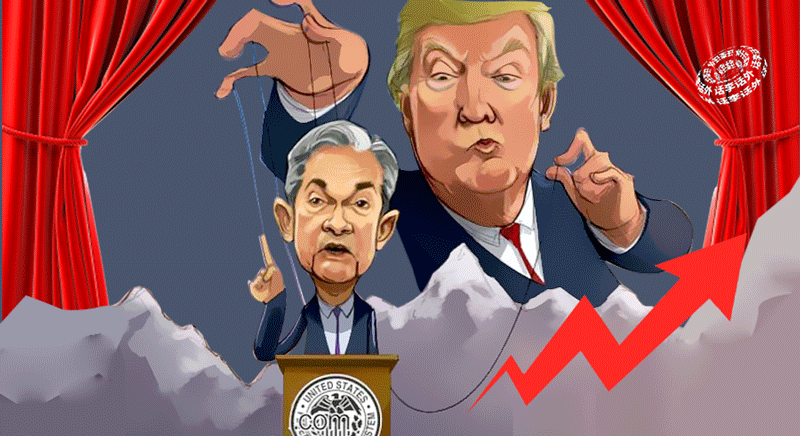
Source: Talking about Li and other things
In yesterday’s (March 11) article, when we were talking about Trump, we mentioned the issue of “debt”. Some friends left messages in the background saying that they didn’t understand. Here we will make a simple expansion and supplement to this topic in the previous article.
First, let's take a quick look at the size of the U.S. debt data:
As the US government's debt scale has been at a relatively high level, according to relevant media reports, as of December 2024, the US government's debt scale has exceeded 36 trillion US dollars, and it is expected that nearly 3 trillion US dollars of US Treasury bonds will mature this year.
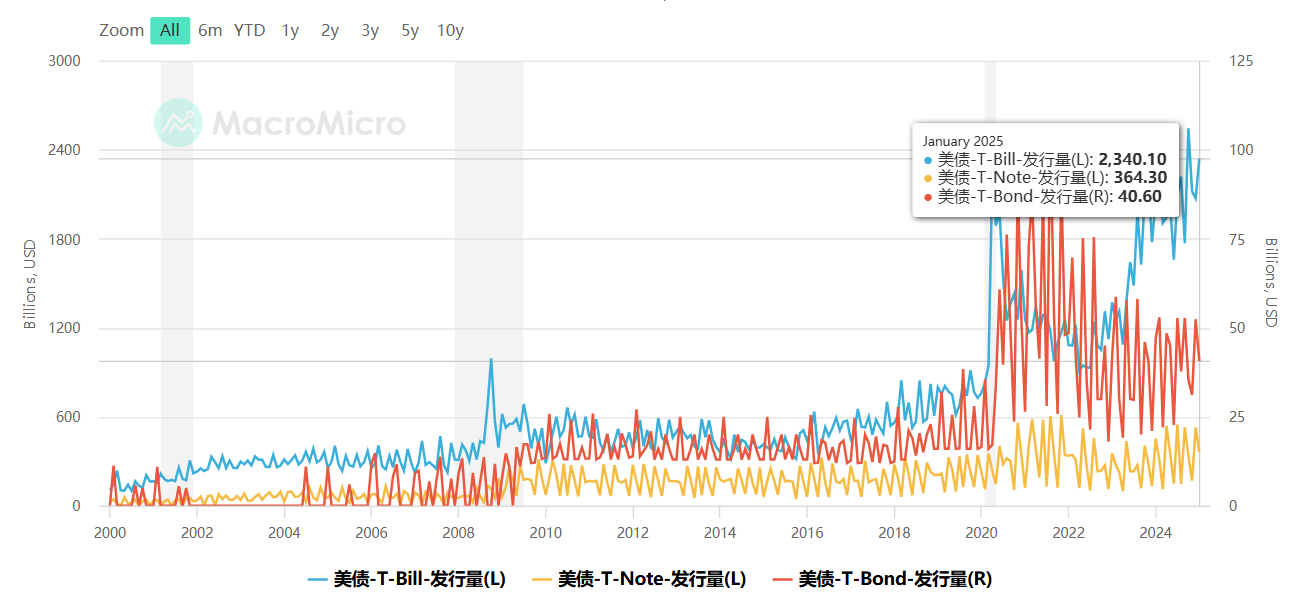
Next, let's take a look at the US 10-year Treasury yield:
The current 10-year U.S. Treasury yield has fallen to 4.27%, as shown in the figure below. Combined with the recent trend of U.S. stocks, in simple terms, the simultaneous decline of U.S. Treasury yields and stocks often means that market sentiment is not good and investors' concerns about the economic outlook continue to intensify.
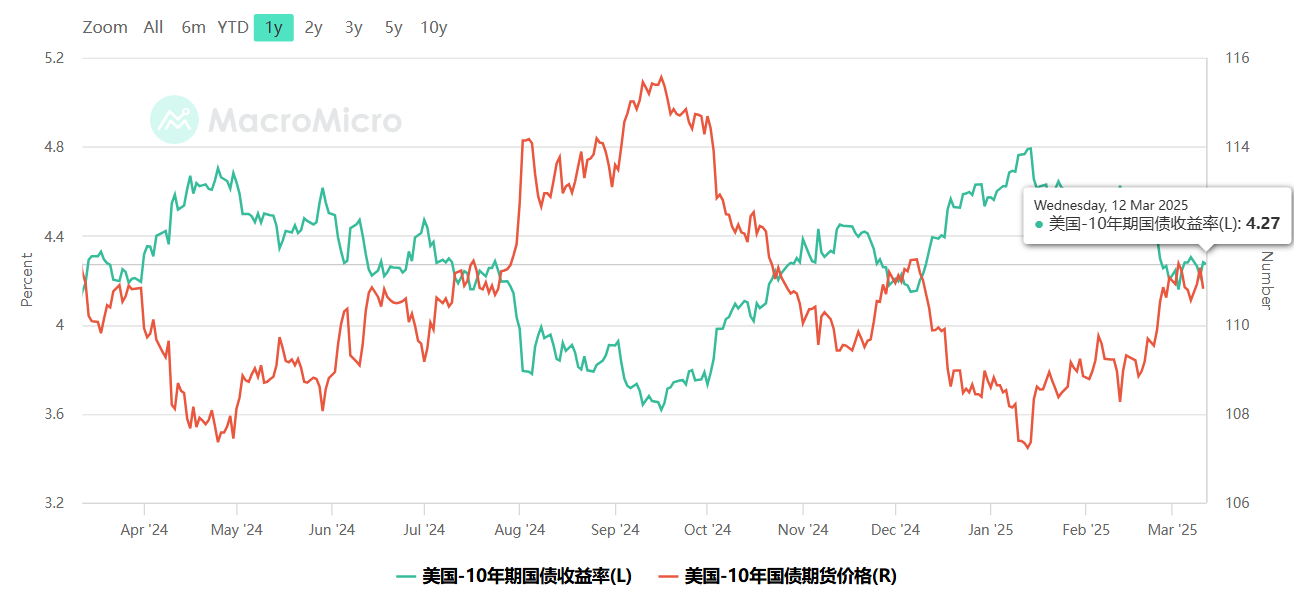
The main reason for the recent market turmoil is Trump’s tariff policy and various uncertainties surrounding Trump himself, which has triggered risk aversion in the market.
If we look at the debt problem and the U.S. Treasury yield problem together, we will find an interesting phenomenon: the increase in global risk aversion will to a certain extent push up the demand for U.S. Treasury bonds, thereby causing a decline in Treasury yields (corresponding to an increase in Treasury bond prices). The decline in interest rates is obviously beneficial to the current situation of the U.S. government because the U.S. government can roll over its debts (that is, issue new bonds to repay old debts) at more favorable interest rates.
To put it simply (guess), Trump does not seem to like the current high 10-year bond yield after taking office, because the interest rate paid by the US government when rolling over its debt is usually closely related to the market interest rate. That is, when the Treasury bond yield falls, the US government can issue new bonds at a lower interest rate, thereby continuing to reduce future debt interest costs.
The above logic can be expressed in plain language: Trump hopes that the market will "crash" to force bond prices to rebound (supplement: a sharp drop in the stock market can directly lead to fluctuations in the financial market, but after the short-term pain, it will continue to form a long-term situation that is beneficial to the US government), so as to reduce bond yields and conduct cheaper government refinancing. Therefore, Trump has done a series of things since he took office, including tariffs and layoffs (what Musk's government efficiency department is currently doing) and other measures mentioned in the previous article. At the same time, the resulting economic recession will force the Federal Reserve to take direct action, because lower bond yields are not only conducive to government refinancing, but may also prompt the Federal Reserve to cut interest rates as soon as possible.
Therefore, in the previous article we said: If Trump wants to quickly become a great American president, the easiest way seems to be to "print money" and make the dollar "great" again, and the easiest way to achieve this at present seems to be to play with "debt."
Of course, the above are still our fantasies and speculations. As for what Trump himself thinks and what the US government plans to do next, only Trump himself knows. As for how the Federal Reserve will respond to the violent market fluctuations and whether it will cut interest rates again in June this year, these issues need to be continuously observed. We can only take it one step at a time.
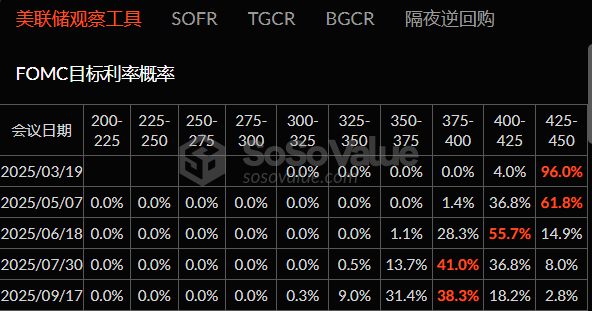
Next, let’s return to the topic of the crypto market.
Since the beginning of this cycle, especially with the official approval of ETFs, more and more institutions are deeply involved in the crypto market, and some institutions (projects) in the crypto market are also establishing closer ties with traditional markets.
Many people say that the current crypto market is becoming more and more like the U.S. stock market. I agree with this statement because there is a high probability that the next crypto cycle will be more consistent with the macro trend and will no longer have its own time operation rules like the previous two bull market cycles.
I remember that in some of our earlier articles, we also mentioned that this bull market (24-25 years) may be the last big opportunity for ordinary people. For example, in the article in December 2023, we mentioned that the next bull market (i.e. this bull market) may be the last opportunity for the crypto market to grow on a large scale. At that time, the reasons and expectations we gave were mainly based on regulation (policy) and institutional participation. As shown in the figure below.
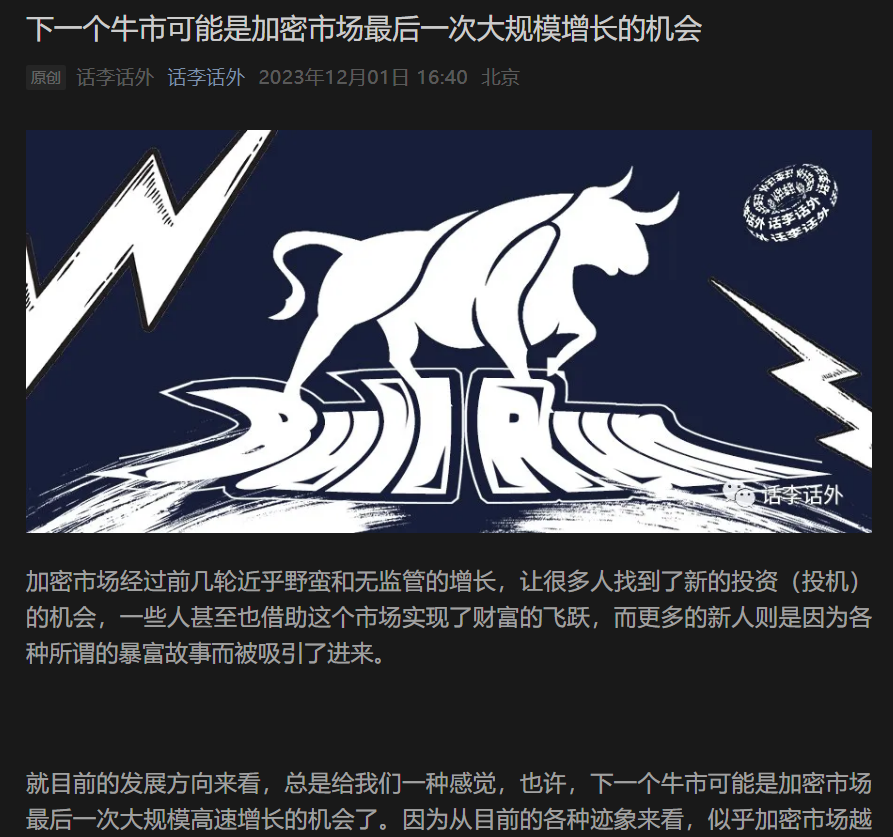
In other words, as more traditional institutions and national teams enter the market, the crypto market will become more and more "formal", which seems to be unfriendly to most ordinary people who hope to get rich overnight or speculate. It means that in the future, we may (this is just a possibility and speculation, no one can predict the future) rarely see the extreme prosperity or extreme depression cycle. If the "change" conditions are met (for details on the topic of change, please see the article of Li Huawai on January 17), then it may even slowly tend to a new trend similar to the slow bull and long bull of the US stock market. Of course, in this long-term development process, I believe that at least 90% of the current massive projects will die or return to zero, which is also a necessary path for the development of things.
If we talk about narratives, so far, among the hundreds of different narratives in the crypto market, it seems that only individual narratives such as DeFi (DeFi3.0 mentioned in our previous article), RWA and Stablecoin have relatively achieved certain breakthroughs (including going beyond the circle) in terms of adoption rate. Others are still mostly at the level of pure hype or even pure air (this is mainly based on the perspective of industry development. In fact, hype and air do not affect someone making money in the crypto field. We need to look at any problem dialectically).
In the first article of this year (2025), we mentioned: Starting from this year, it may indicate that the encryption field will usher in or begin to enter a new era. There may be some things or events that subvert our existing cognition, and each of us will become a participant and witness.
To take a brief look back, in the past 100 days of this year, we have indeed seen many things that subverted our original expectations or cognitions, such as: Xiaohongshu became a refuge for TikTok refugees, the US President and his wife actually issued coins, Deepseek actually ignited a new round of AI development boom and impacted global computing power, the White House held an encryption summit, the United States has a strategic reserve of Bitcoin (although it is currently only in the executive order stage), the largest hacker attack in history occurred (Bybit was stolen for 1.5 billion US dollars), Trump's tariff war was reopened in an unconventional way... and so on.
Let's think about it again. It seems that from this cycle, the investment logic has also begun to change slowly. Those pure speculations have also begun to focus on things or targets that can create value sustainably. From a certain perspective, this is also a sign that the crypto market is becoming more mature. Although speculation will always exist in every financial market, as far as the crypto market is concerned, many past speculative theories (including valuation methods for copycat projects) may be quietly changing. For example, when various speculative narratives are repeatedly used and hyped, and when people are generally tired of PvP games (including scam games), some of the original effective gameplay will lose its effectiveness in stages, unless the market can create a larger (several times larger than before) scale of FOMO factors.
In short, the wild (or barbaric) era of the crypto market will eventually pass, and the early days when you could easily achieve more than 10 times the return by just buying a copycat during the so-called bull market are slowly gone. The market will continue to retain the characteristics of crypto, but it seems to be slowly evolving into a transitional stage similar to the traditional financial market, and liquidity is continuing to flow from people without much investment skills to those with sophisticated technology (people/institutions). But in the long run, this is a positive performance for the development of the crypto industry.
Often, the end of a stage story often means the beginning of a new stage. We just need to grasp the present, look to the future, and continue to be patient.
Let’s talk about this today. The topic seems a bit broad, and we can think about it in more dimensions. The sources of pictures/data cited in the text have been added to Notion. The above content is only personal opinion and analysis, and is only for learning records and communication purposes, and does not constitute any investment advice.













